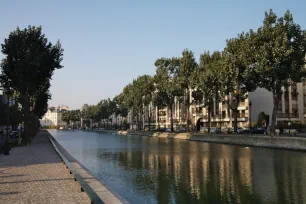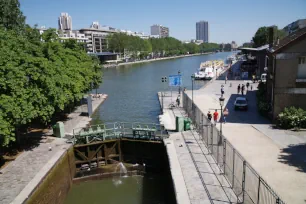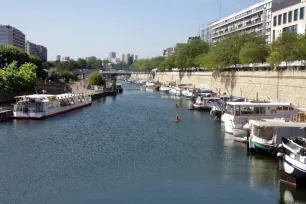The Canal Saint-Martin is a 4.5-km (2.8-mi.) long canal that was part of a trio of canals built in the early nineteenth century to provide Paris with drinking water. Today, the route along the picturesque canal is popular with people looking for a romantic walk.
History


In 1802 Napoleon ordered the construction of a series of canals aimed to provide the growing population of Paris with fresh drinking water.
Three canals with a total length of 130 km were dug during the following decades: the Canal Saint-Martin, the Canal Saint-Denis and the Canal de l’Ourcq. The canals went into service between 1821 and 1825. They were also used as a transportation route, and factories and warehouses were built along the quays.
During the mid-twentieth century boat traffic started to dwindle and in the 1960s there were even proposals to fill in the canal and replace it with a highway.
Location
The Canal St. Martin begins at the Bassin de l’Arsenal, which connects the canal with the Seine river. The canal continues underground at the Bastille Square and re-emerges at the 10th arrondissement, not far from the Place de la République. From there it leads north towards the Bassin de la Villette at the Place de Stalingrad. The basin connects the canal St-Martin with the Canal de l’Ourcq, which cuts through the modern Parc de la Villette and leads to the river Ourcq.




The tranquil environment of the tree-lined Canal St-Martin draws joggers and walkers, especially on summer evenings. Picturesque iron bridges cross the canal, and people often enjoy watching barges navigate the series of lodges.
Basins
The basins to the north and south of the Canal St-Martin were used as ports where canal boats unloaded their wares.
The Port de l’Arsenal at the Bassin de l’Arsenal to the south of the Canal St-Martin is now a leisure port, where yachts and pleasure boats are docked alongside historic riverboats that were converted into houseboats.
At the north end of the Canal St-Martin is the Bassin de la Villette, with a length of 800 meters and a width of 70 meters (2625 x 230 ft) the largest basin in Paris. Once an active port, it is now mainly a leisure and entertainment area. Large canal boats docked at the basin are used to house cultural events, and during summer fishermen and pick-nickers often spend their afternoon at the quay.
Rotonde de la Villette
At the south quay of the Bassin de la Villette is the Neoclassical Rotonde de la Villette, a circular structure that was built at the end of the eighteenth century after a design by the French architect Claude Nicolas Ledoux.
The Rotonde was part of the “mur des Fermiers généraux”, a wall erected around Paris to prevent people from importing goods into the city without paying taxes. The building was used to house tax administrators and guards.
River cruises
An interesting alternative to the popular boat trips along the Seine is a river cruise on the Canal St-Martin and Canal de l’Ourcq. The cruises depart at the Port de l’Arsenal and Bassin de la Villette.

